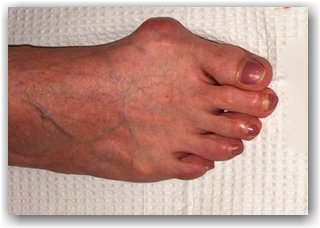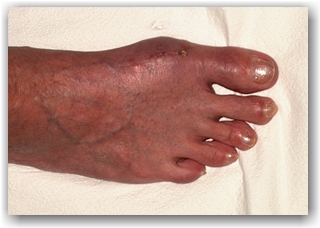Bunion Surgery
Bunion surgery generally involves an incision in the top or side of the big toe joint and the removal or realignment of soft tissue and bone to relieve pain and restore normal alignment to the joint. If the joint is severely deformed, it may be stabilized with tiny wires, stitches, screws, or plates. There are no guarantees that a bunion surgery will fully relieve your pain.

Bunion, before surgery
A regional anesthetic that affects only the foot is commonly used for bunion surgery. A sedative may also be used during the procedure.
The procedure usually takes an hour or more, depending on the type of surgery.
Bunion repairs are usually done on an outpatient basis.
The general types of bunion surgery are:
- Removal of part of the metatarsal head (the part of the foot that is bulging out). This procedure is called exostectomy or bunionectomy.
- Realignment of the soft tissues (ligaments) around the big toe joint.
- Removal of a small wedge of bone from the foot (metatarsal osteotomy) or from the toe (phalangeal osteotomy).
- Removal of bone from the end of the first metatarsal bone, which joins with the base of the big toe (metatarsophalangeal joint). At the metatarsophalangeal joint, both the big toe and metatarsal bones are reshaped (resection arthroplasty).
- Fusion of the big toe joint.
- Fusion of the joint where the metatarsal bone joins the mid-foot (Lapidus procedure).
- Implant insertion of all or part of an artificial joint.
What To Expect After Surgery

Bunion, after surgery
The usual recovery period after bunion surgery is 6 weeks to 6 months, depending on the amount of soft tissue and bone affected. Complete healing may take as long as 1 year.
When you are showering or bathing, the foot must be kept covered to keep the stitches dry.
Stitches are removed after 7 to 21 days.
Pins that stick out of the foot are usually removed in 3 to 4 weeks, but in some cases are left in place for up to 6 weeks.
Walking casts, splints, special shoes, or wooden shoes are sometimes used. Regular shoes can sometimes be worn in about 4 to 5 weeks, but most procedures require wearing special shoes up to 8 to 12 weeks after surgery. Many activities can be resumed in about 6 to 8 weeks.
After some procedures, no weight can be put on the foot for 6 to 8 weeks. Then there are a few more weeks of partial weight-bearing with the foot in a special shoe or boot to keep the bones and soft tissues steady as they heal.